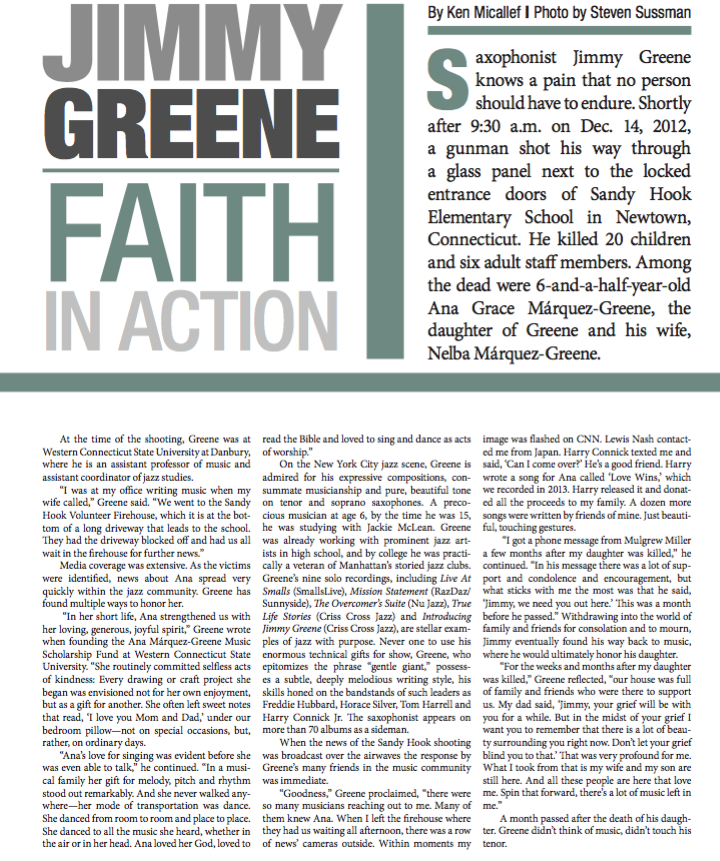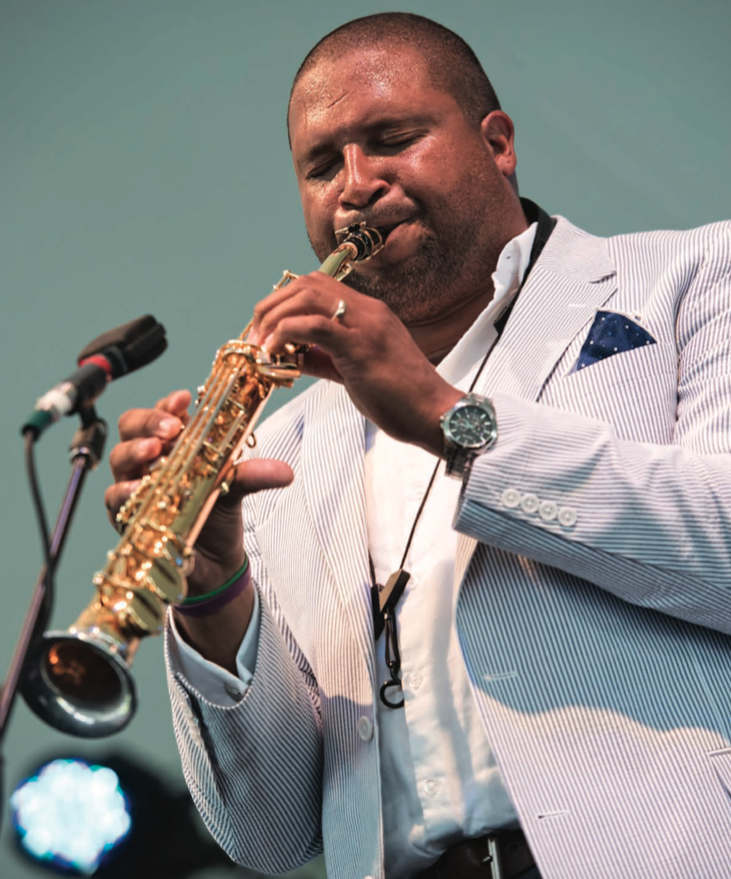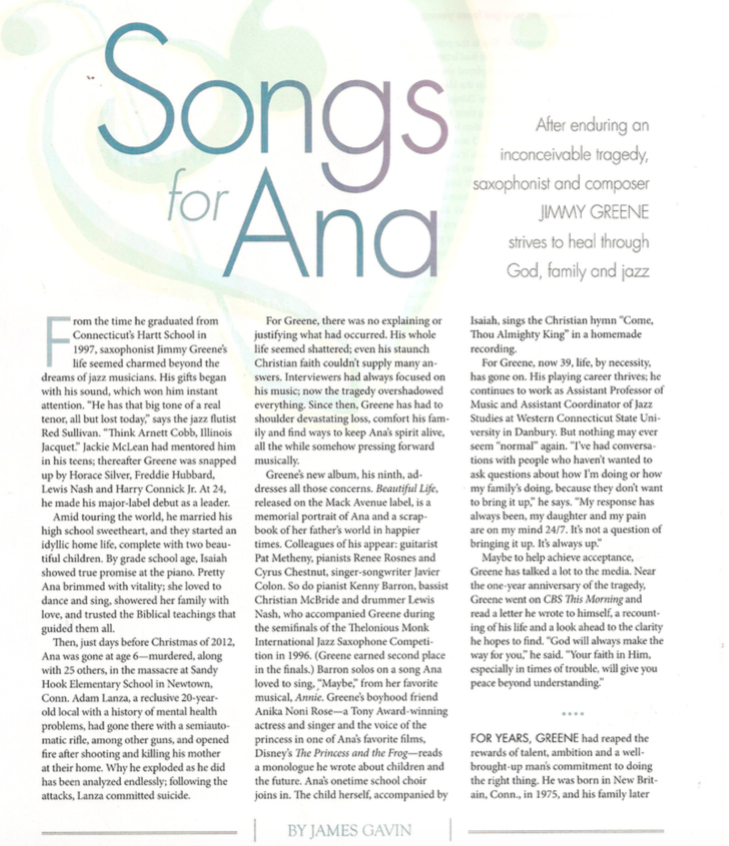Press
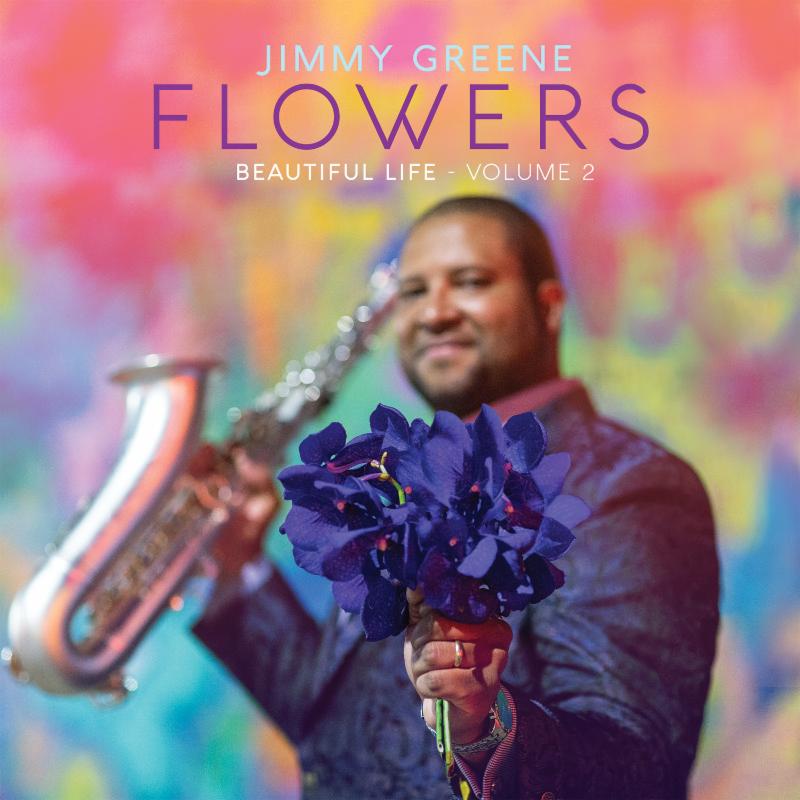 Jimmy Greene: Flowers: Beautiful Life--Volume 2
Jimmy Greene: Flowers: Beautiful Life--Volume 2
By Mike Joyce
08/15/2017
Like Beautiful Life, its Grammy-nominated companion album of 2014, Flowers was born of deep, unimaginable grief, following the death of saxophonist Jimmy Greene's 6-year-old daughter, Ana, who was murdered at Connecticut's Sandy Hook Elementary School in 2012. But whereas the previous recording was soulfully elegiac, "Flowers" is often joyfully kinetic--a rhythmically vibrant, sometimes harmonically audacious expression of love, inspired by a young girl's passion for dance. A reed section unto himself, playing soprano, alto, tenor and baritone saxes, Greene thrives in the animated company of a stellar lineup that includes keyboardists Renee Rosnes and Kevin Hays, bassists John Patitucci and Ben Williams, and drummers Jeff "Tain" Watts and Oscar Brown III.
"On this album, I envision Ana asking us to dance with her," Greene informs us in his liner notes, and it's not hard to imagine a child's loose-limbed response when he and Brown vigorously spar on "Stink Thumb," or when the reedman matches wits with Watts on "Fun Circuits" and "Stanky Leg." Not that the session is without tender moments. Vocalist Jean Baylor helps fashion a poignant interlude on "Someday," with words and music by Greene. Singer Sheena Rattai is similarly expressive on the album's title cut. Strains of blues and samba also help throw the uptempo pieces into sharp contrast. From the Jackie McLean-tinted opener "Big Guy" onward, Greene plays with assurance and clear purpose while providing his colleagues with a winning selection of fresh tunes.
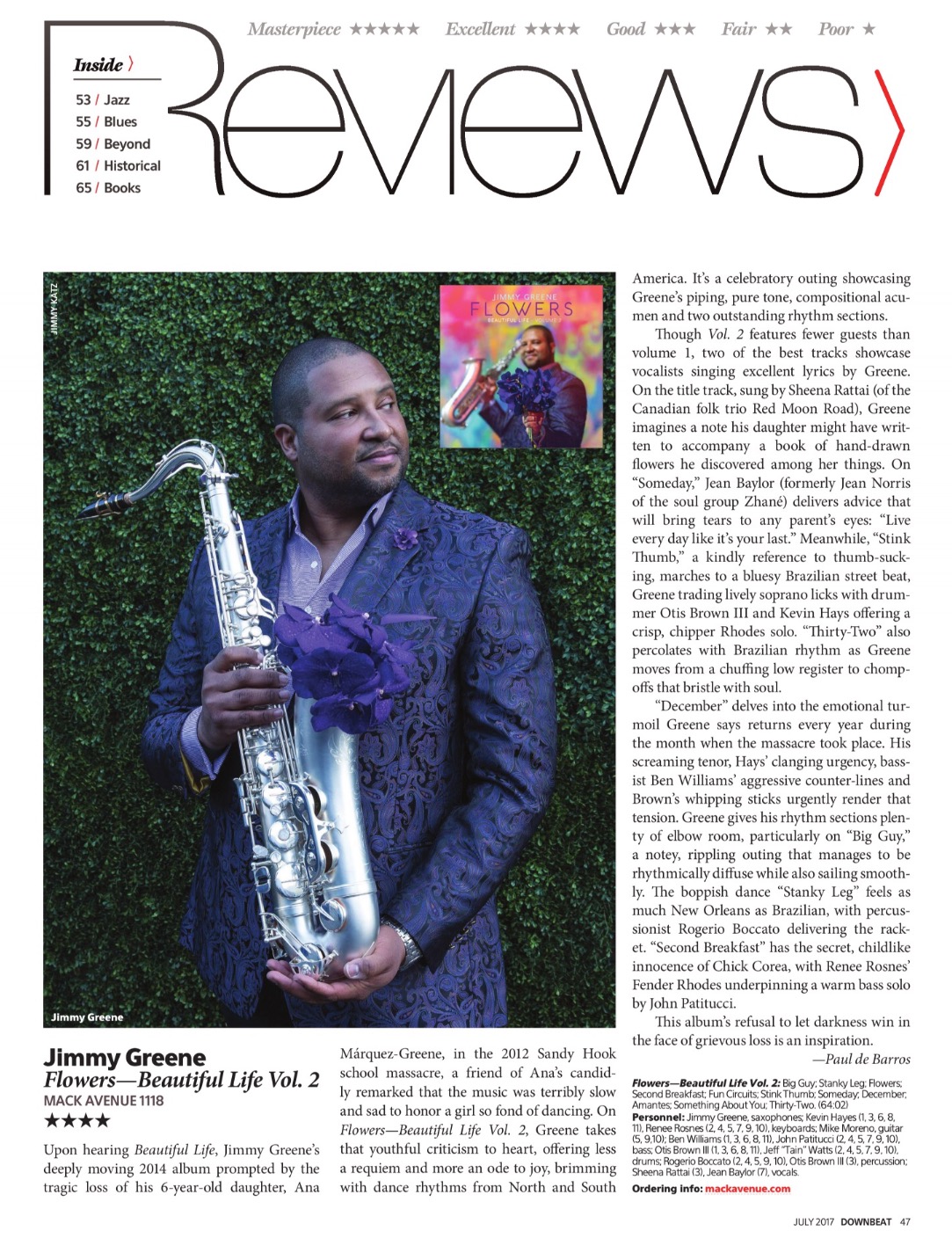
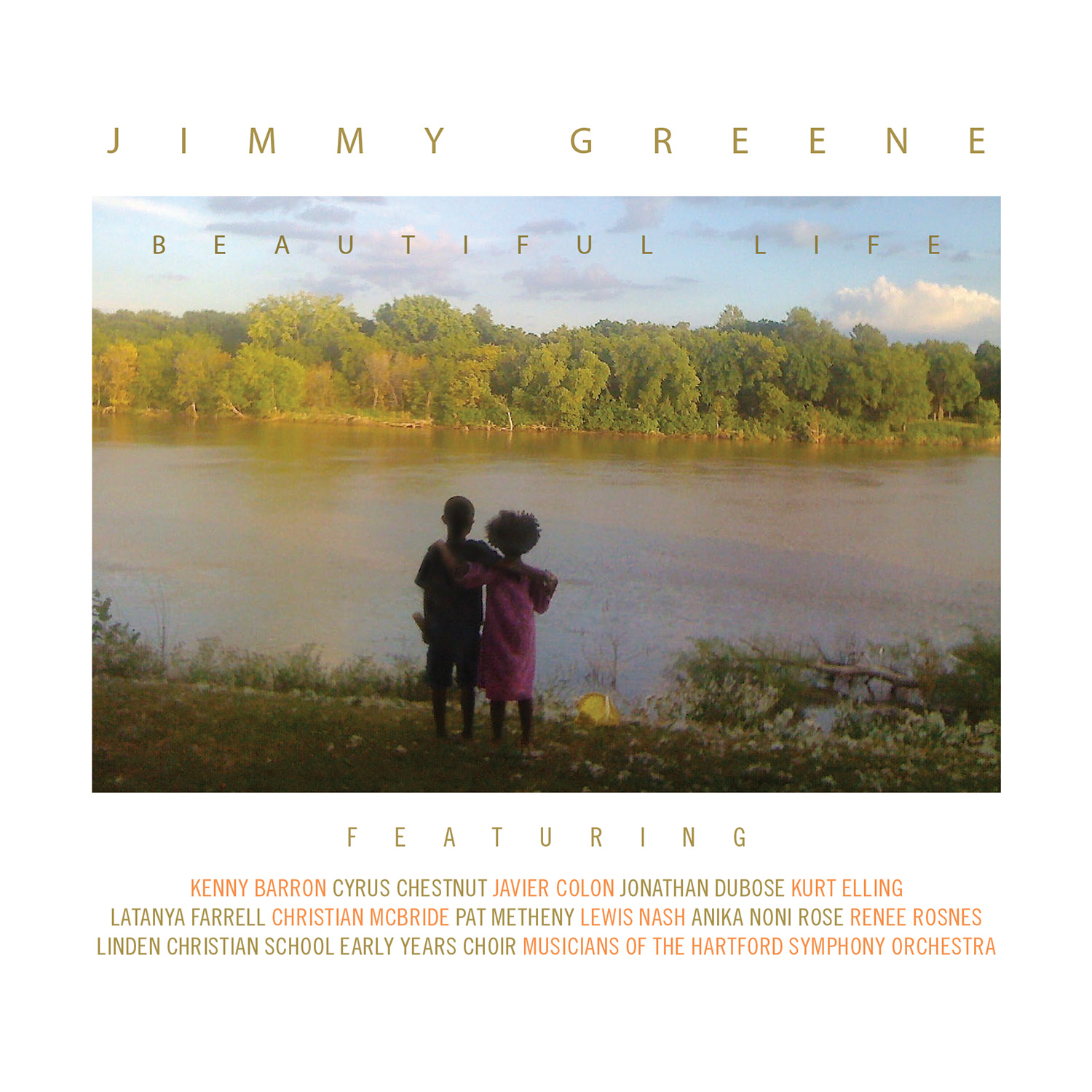 Years After Newtown Massacre, a Father Plays Through the Pain
Years After Newtown Massacre, a Father Plays Through the Pain
By PHILLIP LUTZ
AUG. 26, 2016
Jimmy Greene preparing the music before an Aug. 16 set at Birdland in Manhattan with the trumpeter Randy Brecker. Credit Michelle V. Agins/The New York Times The saxophonist Jimmy Greene and his wife, Nelba Márquez-Greene, lost their 6-year-old daughter, Ana, in the Sandy Hook Elementary School massacre in Newtown four years ago. Mr. Greene has had success in addressing the loss musically -- a tribute to Ana released in 2014, "Beautiful Life," earned two Grammy nominations -- but the pain endures.
"I still think of my little girl every moment of every day," he said.
Yet Mr. Greene, 41, is moving the needle artistically, and perhaps psychologically. This month, he completed studio work on another, more animated recorded tribute and spent five nights as a sideman at a club in New York City. Next month, he will lead bands at clubs in New York and Stamford and at a concert hall in his native Hartford, where he will draw on the new music.
"It's extremely helpful dealing with the complex emotions that the grief process brings on," he said of the activity.
Sitting in his studio at Western Connecticut State University in Danbury, where he is an assistant professor of music, Mr. Greene, a big man with a ready smile, said that, in recent months he had become physically stronger and better able to focus. He credited the good wishes, and occasional largess, of family, friends and colleagues.
Prominent among them is the pianist Renee Rosnes. The only musician recruited for both "Beautiful Life" and the new album, Ms. Rosnes, who like Mr. Greene is a fixture in the jazz mainstream, said she had noticed a change in him.
"He's a great talent who would have developed into the musician he is today regardless," she said. "However, I believe that there might be a certain intensity in the way he plays that is directly related to what happened to him."
That intensity was evident on a Tuesday night this month before a packed house at Birdland in Manhattan, where Ms. Rosnes led a quintet through the songbook of her former colleague and an influence of Mr. Greene's, the saxophonist Joe Henderson.
Offstage, Mr. Greene focused intently on Isaiah, now his only child, who sat with him at a side table. Onstage, with Ms. Rosnes lending moral and musical support, Mr. Greene's solos revealed a wide emotional range -- his low notes, big and round, seeming to plumb the depths of despair; his high notes, light and looping, reaching heavenward.
Back in his studio, he spoke with a low-key sense of urgency about the new album. It grew, he said, out of a critique offered by a young friend of Ana's during a performance of music from "Beautiful Life" at the university in December 2014. The friend told Mr. Greene's wife, a marriage and family therapist, that the songs were slow and sad, but that Ana was anything but. Mr. Greene quoted the friend as saying, "Ana would like something she could dance to."
"I really appreciated that insight," Mr. Greene said."So this album is a much more lively, danceable, rhythmic expression than the last one."
For the album, which does not yet have a name, Mr. Greene did not use the children's choir, the string section and the small army of jazz musicians who appeared on "Beautiful Life." In their place are two agile combos, one of which includes the players who appeared at the December 2014 concert: John Patitucci on bass, Jeff "Tain" Watts on drums and Ms. Rosnes.
The band, which will join Mr. Greene at the Bushnell Center for the Performing Arts in Hartford on Sept. 23, is called Jimmy Greene's Love in Action. The name reflects the message that Mr. Greene said he is keen to put forward: "Love is a set of actions."
Mr. Patitucci's presence should help advance that message. Beyond his great skill on the bass, he is known in the jazz community for his joyous mien and his adherence to his Christian beliefs -- traits, he noted, that he has in common with Mr. Greene.
"He's a spiritually deep person, with a huge faith," said Mr. Patitucci, who reached out to Mr. Greene after Newtown. "That's something we share. When I hear his music, I hear the kind of beauty that speaks to the beauty of the divine."
Mr. Patitucci cited "Ana's Way," a restrained exercise employing the choir from Ana's former school, the Linden Christian School in Winnipeg, Canada, as music from "Beautiful Life" that moved him. He also mentioned "Last Summer," a quartet number that Mr. Greene was reworking for his large ensemble, the Big Jimmy Greene Band, which will appear at the 9th Note in Stamford on Sept. 10 and at Dizzy's Club Coca-Cola in Manhattan on Sept. 12.
That piece tempers its pathos with a rhythmic kick, foretelling the brighter approach on the new album. At its extreme, that approach is expressed in what Mr. Greene called "comical, silly" material like "Stink Thumb," which derives its title from Ana's fascination with thumb-sucking and its odorous aftermath. The album, suffused with South American and Afro-Cuban rhythms, reunites Mr. Greene with the Brazilian percussionist Rogério Boccato, who taught at the Hartt School in Hartford. There, as a student, Mr. Greene made contacts that gave him entree to the top ranks of the jazz world.
As a globe-trotting artist and educator, he took a job teaching at the University of Manitoba in Winnipeg. He returned to Connecticut only months before Ana was killed.
The impact of that decision was not lost on him. But after receiving condolences from places far and wide, Mr. Greene -- born in Hartford, raised in East Hartford and Bloomfield -- still finds it comforting finally to be living and working close to home.
"It's always nice to see familiar faces in the audience," he said. "You feel there are people who know you and understand you already out there."
 A Wrenching Grief Assuaged With Beauty, Jimmy Greene's 'Beautiful Life' Is a Eulogy to a Daughter
A Wrenching Grief Assuaged With Beauty, Jimmy Greene's 'Beautiful Life' Is a Eulogy to a Daughter
By NATE CHINEN
NOV. 26, 2014
Jimmy Greene's album "Beautiful Life" honors his 6-year-old daughter, killed at Sandy Hook Elementary School. Credit Karsten Moran for The New York Times There's a calmly heartbreaking moment near the close of "Beautiful Life," a poignant new album by the saxophonist Jimmy Greene. It arrives in "Little Voices," an original poem read by the actress Anika Noni Rose. "All those precious little voices," she says over a fluttery gospel groove. "Brightening our day, stealing our hearts, shaping our lives." Then: "In the blink of an eye, they're gone. Now there's just silence where those little voices used to be."
The context behind these words is wrenchingly clear. Mr. Greene, a substantial figure in the modern jazz mainstream, was among the parents who lost a child in the 2012 mass shooting at Sandy Hook Elementary School, in Newtown, Conn. His daughter, Ana Márquez-Greene, was 6.
"Beautiful Life," out this week on Mack Avenue, is his attempt to reclaim her memory from the grip of tragedy. "Much attention has been paid to the way in which my precious Ana died," he writes in the liner notes, "but this album attempts to paint the picture of how she lived -- lovingly, faithfully and joyfully." Featuring an array of notable singers and instrumentalists with ties to the Greene family, the album wears its purpose plainly. Its opening track segues from a ruminative duet between Mr. Greene and the guitarist Pat Metheny, playing "Come, Thou Almighty King," to an audio clip of Ana singing that hymn at home with her older brother, Isaiah, on piano. What possible evaluative response can there be to a work of art so painfully personal, so inexorably shaped by calamity?
I've been struggling with that question since I learned of Mr. Greene's effort to make this album, more than a year ago. Enough, perhaps, to let the world know that it exists, and applaud the earnest fortitude behind it. That approach has guided most of the coverage around the album, often with thoughtful commentary from Mr. Greene himself. I can't explain why my instincts registered so strongly in favor of some other tact: a respectful distance, an observant silence, the tentative wait and see that ultimately led me here.
I can hardly recall the horrific news from Newtown, on Dec. 14, 2012, without the immediate aftershock of correspondence among Mr. Greene's friends and peers in jazz. As a critic, I'm a few degrees removed from that circle, but a part of the same ecosystem -- and human, besides. As the father of a small daughter at the time, I felt an especially empathetic bond with Mr. Greene and his wife, Nelba, even as I strained to imagine the scope of their suffering.
I also took note of the tributes that emerged: from Mr. Greene's former boss Harry Connick Jr., who wrote and released a gospel tune called "Love Wins"; from the pianist George Colligan, who included a new ballad, "Thoughts of Ana," on an album released last year; from the trumpeter David Weiss, on a new album pointedly titled "When Words Fail." (There have been others.) But Mr. Greene brings a perspective that no outside party could truly understand, and knowing that much is the challenge behind any critical engagement with the music.
Portions of "Beautiful Life" are subtly touching, and stylistically in line with his previous work. With the pianist Renee Rosnes, the bassist Christian McBride and the drummer Lewis Nash, Mr. Greene stamps several originals with a clean postbop assurance. But he also plays a pair of duets with the pianist Kenny Barron, including a version of "Maybe" -- one of Ana's favorite songs, from the musical "Annie" -- that's gorgeous in its stillness, and devastating in its effect.
The pieces with vocals are more direct, and more exposed. "When I Come Home" is a reworking of Mr. Greene's ballad "Home," with lyrics about yearning for a heavenly reunion. It's a premise made familiar both by hymns and popular songs, like Eric Clapton's "Tears in Heaven," which also came out of a personal loss. But the writing is artfully nonspecific, and the vocal performance -- by Javier Colon, a former conservatory classmate of Mr. Greene's who won the first season of NBC's "The Voice" -- is sensitive and supple, in a Stevie Wonder vein.
The singing is just as expressively restrained on "Ana's Way," which features Kurt Elling, and builds on a composition previously titled "Ana Grace." But the lyrics are far more personal, eulogistic in tone and detail. And during the latter part of the song, Mr. Elling is joined by a children's chorus, made up of Ana's former classmates from a three-year stretch when the Greenes lived in Winnipeg, Manitoba.
Try as I might, I can claim no pretense of objectivity with this song. I recoil slightly from the searing pathos, but something -- the sinuous Wayne Shorterish melody, mixed with the inescapable back story -- keeps me locked in. Since I first heard it, "Ana's Way" has been the track on "Beautiful Life" that keeps replaying in my mind's ear.
Five years ago, I reviewed an album by Steven Curtis Chapman, the contemporary Christian singer-songwriter, that grappled with the accidental death of his 5-year-old daughter. A few songs from that album, "Beauty Will Rise," held a similar grip on my psyche for some time, partly, I think, because of their honest engagement with boundless grief and battered faith.
But there's also a quiet resilience in those songs, as in most of Mr. Greene's. There may be no way to approach "Beautiful Life" with critical impartiality, but that hardly discredits my admiration for the album. Even "Little Voices," the most heavy-handed track, takes an elegant turn, toward a love-your-neighbor exhortation.
And it ends with the children's choir singing "Remember me," as a soulful refrain. It's easy to imagine one more voice among them, small but strong.

Tough to hear: Father grieves for his daughter through jazz
By: Carol Banks Weber
Nov 5, 2014
Beyond jazz, saxophonist Jimmy Greene is a father. On December 14, 2012, this father lost his six-year-old daughter Ana Márquez-Greene to a mentally disturbed gunman run amuck at Newtown, CT's Sandy Hook Elementary. There are no words.
But perhaps there is enough music to sustain such a short life through the hands, voices, and beats of these profoundly changed artists throwing in with Greene on Mack Avenue's upcoming November 25th release.
"Love will outlast this life," Javier Colon sings on "When I Come Home." This is the theme throughout Greene's Beautiful Life. Proceeds will go to the Ana Grace Project of Klingberg Family Centers and the Artists Collective. Colon is a fellow graduate of the prestigious Hartt School of Music, and the 2011 winner of NBC's The Voice. His voice on Greene's lyrics carefully touches upon the points of emotional entry, brushing against eternity.
The musicians on this album provide ample testimony to a beautiful life lived despite the sudden, violent end. Together on various tracks -- there are 10 little voices tugging at the heartstrings -- they use Ana's senseless death to enrich those who survived her. When the children's choir raises its "Little Voices" in the refrain, "Remember Me," it's hard to get through. It was hard for Greene and his musicians.
After Sandy Hook, Greene had no interest in music. "In the days after my daughter was killed, playing and writing music wasn't even a thought," said Greene, 39, in a recent DL Media press release. "I was very much in shock, grieving deeply and trying to just function coherently. Family and friends surrounded us and held us up, and we received 10,000 communications -- emails, texts, Facebook messages, voice calls, letters -- from people around the world. The community of musicians was front and center for that support. When I called, they responded, ‘Whatever you need, just say the word, and I'll be there.'"
By January 2013, Greene was ready. So was Norman Chesky, of Chesky Records and HDtracks. He offered to comp for an entire recording, whatever the saxophonist wanted. Greene soon put pen to paper, writing songs, arranging favorite spiritual and classical pieces, and bringing the instrumentalists and singers together -- first and foremost, his late daughter Ana.
That's her on the first track, "Saludos/Come Thou Almighty King," with her dad and guitarist Pat Metheny blended in. Her vocals came from a recording at a Puerto Rican Christmas with her mom's family, a year before Sandy Hook, for the "Saludos" part. She sings again in a recording of a hymn she did with her brother Isaiah on piano at the end of the moving medley.
"Ana loved to sing and listen to singers, and had a wonderful singing voice. So an album dedicated to her memory needed to have singers and songs that were important to her and me and my family," Greene continued.
The DownBeat Rising Star gathered a stirring group of famous artists together for this album: Tony Award-winning actress Anika Noni Rose, who provides the uplifting spoken word ("Will you love your neighbor?") before the children's chorus in "Little Voices," pianist Cyrus Chestnut and Latanya Farrell in "Prayer," vocalist Kurt Elling for "Ana's Way," Pat Metheny on guitar, Christian McBride on bass, Lewis Nash on drums, Kenny Barron, the Hartford Symphony Orchestra, and on and on.
"[The Lord's] Prayer" will bring you to your knees on the strength of Farrell's vocals, Greene's pronounced sax, and Chestnut's exquisite piano notes. Farrell's was a voice Ana so loved to hear as a toddler.
"Ana's Way" nearly brought Greene and his band to their knees during the recording process. The Linden Christian School Early Years Choir accompanied Kurt Elling. They included some of her and her brother's classmates back when they lived in Winnipeg, Canada. Seeing their familiar faces but not Ana was "brutal" on the father, but he pressed on. The original instrumental ("Ana Grace") became putty in Elling's and the choir's hands in a tender mix of gospel innocence and Motown strength.
Jimmy Greene's love carries through all the songs, whether he's laying his soul down on tenor or soprano, or flute. It is when the children lend their happy, pure voices to the choir -- a thread that never truly fades, thank god -- that this album takes on a life of its own, and we remember Ana as she was.
Greene could easily have gone down a darker path musically -- and nobody would've blamed him. It's easier to feel broken up by hatred and grief than propelled by the divine force of love, forgiveness, and inspiration. This accomplished jazz musician chose the high road, because he remembered his daughter. This is for her and all the children. He played all the songs by all the people she most enjoyed. He played for her.
"I want the music to reflect the way that Ana lived." Her spirit resides in the somber but lyrically flecked "Wonder," the rush of intoxicating worship in "Your Great Name," "Prayer," and "Little Voices," the simple jazz interplay of "Seventh Candle," and bass-heavy stomp of "Last Summer."
Beautiful Life is a beautiful, touching tribute. Have tissues handy.

Review of Beautiful Life
jazz.about.com
By Michael Verity, Jazz Expert
I don't generally review records in the first person but this one deserves a more personal touch.
I was going to review Jimmy Greene's Beautiful Life CD as a part of an article called "4 New Jazz Albums You'll Probably Like," which was to include albums by Jeff Coffin and the Mutet, Branford Marsalis and Joe Hakim. As I slipped the disc into my car player for an "on the way to somewhere listen," I happened to flip over the case and read the inscription on the back. It says:
"My daughter Ana was born on a Tuesday morning in early April 2006. Her life was ended in her first grade classroom on a Friday morning in mid-December -- six years, eight months and ten days later. Despite the efforts of many to identify and debate the issues surrounding the Sandy Hook shooting, an awful reality remains -- there has been a proliferation of heinous, senseless acts of violence in America -- acts that have ravaged my families and the families of so many others across our country. Much attention has been paid to the way my precious Ana died, but this album attempts to paint the picture of how she lived -- lovingly, faithfully and joyfully. In a way, this recording also represents a reaction. Not a reaction to the discourse sparked by the events of December 14, 2012, but rather the reaction of a father after having witnessed a miracle -- the miracle of his daughter's beautiful life.
With this recording there is an assertion that, despite the unseemingly bearable weight of our loss, there is still lots of beauty all around and much to be thankful for in this life. I'm grateful that my Dad reminded me of this fact in the days after Ana was killed because from that moment, my focus gradually shifted from inward to outward, eventually resulting in this recording. And, I'm thankful for the opportunity to share this music, and a bit of Ana's beautiful life with you."
Love wins, Jimmy Greene, Newtown, CT
Reading this inscription alone, as the father of a beautiful girl who just turned 12 years old a few days ago, was enough to choke me up, to knock the wind out of me, to make feel-- in some very small way -- what it must be like to walk in Greene's shoes. Hearing the voice of his dear Ana on the record and the beautiful expression of love in the Greene's playing -- from the very first cut on the album -- caused me to pull my car to the side of the road and cry...for all the kids in this world like Ana, who have been senselessly murdered in their innocence, and for all the Dads (and Moms and grandparents and brothers and sisters) who have mourned them. For all of us who have mourned them.
And so it is that this is the most important jazz record of the year. Not because of how it was played or how it was recorded or who appeared on it or what melody was most pleasant to me at the moment. This is the most important jazz record of the year because it does what every record -- jazz, rock or otherwise -- should do: it speaks to the breadth of human emotion, from deepest sadness to greatest joy, in the context of what we all aim to achieve -- a connection to the spirit that gives us the courage to forge on in this fragile, temporal life.
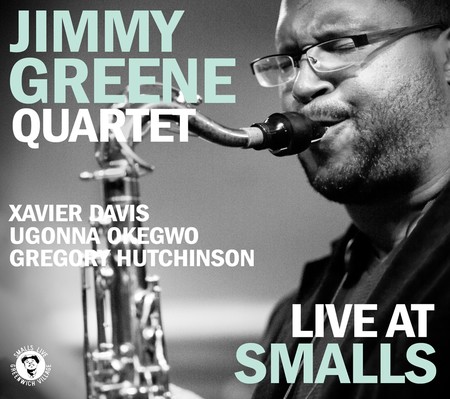
Review of Live at Smalls
Jazztimes
By Thomas Conrad
The new smallsLIVE label is now up to 16 titles. It should not be confused with Luke Kaven's Smalls Records, the label that grew out of the original Smalls and made some classic albums there, like Hewitt's Out of the Clear Black Sky and Omer Avital's Room to Grow. The new label has not yet released anything as important as the best stuff on Smalls Records, but these three new releases are worthwhile, especially the Jimmy Greene.
Those who know Greene through his articulate tenor saxophone work with Tom Harrell will be startled by the first track here. The title, "Sense of Urgency," is an extreme understatement. Greene's commanding opening calls accumulate complexity over an obsessive crashing vamp by bassist Ugonna Okegwo and pianist Xavier Davis. Drummer Gregory Hutchinson storms and rages. Greene's solo gets caught up in wild spins then splinters into jagged fragments. The rest of the album is more measured, and even has two grainy soprano saxophone ballads, but stays intense.
The very best thing about the smalls-LIVE series is how these recordings recreate the visceral experience of Smalls, the hang itself. Engineer (and celebrated jazz photographer) Jimmy Katz comes up close on every instrument--appropriate for a club with 60 seats--but also lets in the applause, the tinkling glasses, the night air. One caveat: The fades of applause and announcements are unfortunate production decisions. They interfere with the fantasy that you are there.
Review of Live at Smalls
Ottawa Citizen
By Peter Hum
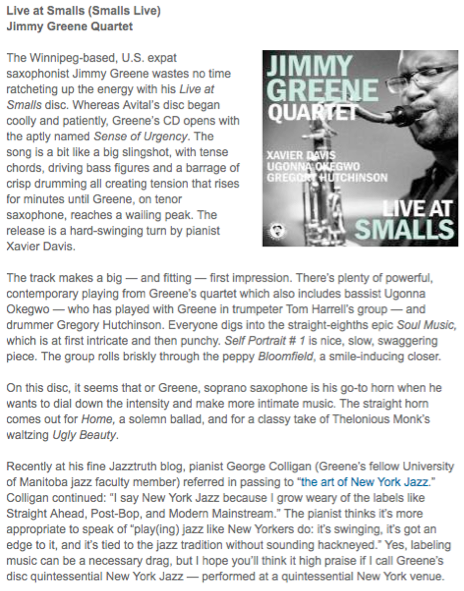

Review of Live at Smalls
NYC Jazz Record, September 2011
By: Graham Flanagan
Since the 90s, saxist Jimmy Greene's flawless technique and muscular sound have consistently landed him at the top of lists of rising-star tenors.
On Live at Smalls, Greene is captured at the height of his considerable powers, supported by pianist Xavier Davis, bassist Ugonna Okegwo and drummer Gregory Hutchinson. The quartet opens with the aptly named "Sense of Urgency", a hurtling Greene composition employing a booming ostinato in the bass and piano parts that carries over into the leader's blistering solo and becomes the dramatic crux of the first half of the performance. Against this harmonically static, but tumultuous rhythmic backdrop, Greene leaps between a series of densely constructed improvised phrases that build progressively to an ecstatic conclusion. He switches to soprano for the album's two ballads - Monk's "Ugly Beauty" and his own "Home". The former is a study in group interplay, thematic development and the kind of effortless swing that Monk's tunes demand while the latter finds Greene leading the group in and out of whispered sections with his exultant lines and dramatic crescendos. Live at Smalls ends with "Bloomfield", an uptempo flag waver that once again showcases the incredible cohesion of this band.
The SteepleChase label's Jam Session series has been a longtime favorite of the label's devotees, so it is fitting that the 30th, and final, installment should feature an allstar cast of four saxophonists along with the longtime house band of pianist Andy LaVerne, bassist Steve LaSpina and drummer Billy Drummond. Joining Greene on tenor are Stephen Riley, Don Braden and Wayne Escoffery - each an accomplished soloist with a distinctive sound and style.
From the opening notes of "Back Up", a blues head by organist Larry Young, it's clear that each of the saxophonists is fully committed to the mix of competitiveness tempered by musicality required of jam session participants. Following a straightforward reading of the melody, Braden leads things off with a soulful, bracing statement, followed by an understated, almost-whispered solo by Riley and two ebullient declarations from Greene and Escoffery, respectively.
Following LaVerne's surprisingly upbeat original "Twin Towers", which finds Greene once again exploring the upper reaches of his altissimo range, the band opens the only ballad - and, arguably the disc's high point - "Darn That Dream", with a delicate intro by LaVerne and a gorgeously intoned statement of the melody by Riley. The track eschews much of the fireworks that characterize the rest of the album's performances, but showcases each of the horn players at their absolute pared-down best. Following the final restatement of the melody, each tenor takes a cadenza and the song fades out as quietly as it entered.

Review of Live at Smalls
Downbeat
Four Stars ****
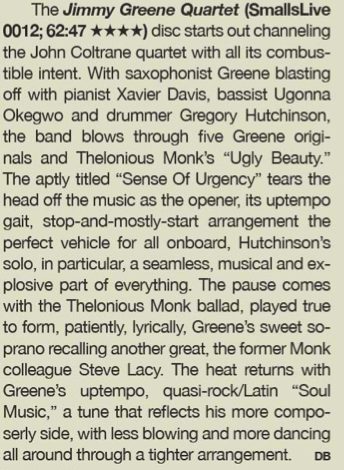

Review of Live at Smalls
Special to The Courant The Hartford Courant
By: OWEN McNALLY
Hartford jazz fans have watched the great tenor saxophonist/bandleader/composer Jimmy Greene evolve from an exceptionally gifted young player at Bloomfield High School and a premier protege of the legendary Jackie McLean into a major mature artist.
Greene, now 35, mixes his musical intelligence with passion and spirituality. His urgent sense of swing and fluent phrasing connect with a diverse, knowledgeable audience. Greene's parents, James S. Greene Sr. and Renee Simmons, started him out on alto saxophone when he was only 6. From that baby step, Greene has forged his own artistic identity. He has earned a room full of citations and plaques as a sideman for luminaries ranging from Horace Silver to Tom Harrell, and as a leader of his own bands.
A summa cum laude graduate of The Hartt School (class of 1997), the soft-spoken tenor titan has an impressive resume. His credits include not only his status as a prime-time performer and composer, but also as an educator, including his present position at the University of Manitoba.
Greene comes out swinging on his latest CD, "Jimmy Greene Quartet: Live at Smalls," one of five new live recordings released by Smalls, the Greenwich Village jazz club which has become a hothouse for cultivating emerging young talent on the New York scene. All five releases are on smallsLIVE, and are, according to the label's credo, "dedicated to the idea that jazz is best heard in a live context with minimal editing, captured in the full spontaneous moment in which it was created." Along with Greene's release, the label's premiere batch of CDs features bassists Omer Avital and Ben Wolfe, drummer Ari Hoenig and a solo piano recording by the club's owner, Spike Wilner.
Excellent examples of minimalist packaging and maximalist attention to the music, each CD is simply titled "Live at Smalls," plus the name of the performer, and features striking black-and-white photographs of the artists. Each disc is generally the result of a two or three night run in the club. With a super rhythm section of collaborators, Greene comes out smokin' on "Sense of Urgency," one of his five originals that make up the CD's six selections along with Thelonious Monk's "Ugly Beauty." In the crackling, in-the-moment spirit of Miles Davis live at the Blackhawk, Greene grooves on tenor and soprano with the great pianist Xavier Davis, bassist Ugonna Okegwo and drummer Gregory Hutchinson.
After that first steaming sample of pure Greene energy, the quartet pays homage to the Monk piece. Next up, "Soul Music" is a spirited freedom jazz/soul dance, generating an earthy, Eddie Harris-like mood for the 21st Century. The final three tracks range from modal to museful to a powerfully dramatic grand finale.
On "Self Portrait #1" and "Home," Greene paints sound pictures that range from the reflective to the searing. And on the celebratory curtain-closer, "Bloomfield," a piece dedicated to his beloved hometown, he plays tenor with authority, ease and fluency recalling Sonny Rollins.
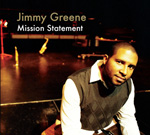
Review of Mission Statement
Night Life Exchange
By:George Carroll
The erudite yet singular sax sound of a jazzman on a mission!! A mission indeed, & Jimmy Greene has composed a spate of originals that we will have to reckon with as the jazz idiom unfolds now and in years to come.
Greene delivers his jazz in an educated, intellectual, and in certainly a literate and learned style. Jimmy's talents are realized in a passionate, albeit a contemporary style.............sometimes tender...............never brutal.................exuding a extraordinarily caressing tone...............handling both his melody and harmony as if to savour and consume. What a gift!! Greene's music is functional and might I suggest that Jimmy's music ''is for the people.'' Jimmy's phrasing and melodic articulation plus his viable pliant timbre makes us his listeners aware not of the sax's limitations in the jazz, (if there are any).....but rather its real communicative strength.

Review of Mission Statement
Something Else!
April 2009
By: Pico
Well, today comes a new release by a member of the NJCO, the young tenor and soprano sax sensation Jimmy Greene. Called Mission Statement, I'm again reminded of his talents both as a player and composer.
Greene can compose some rather urbane, well-conceived jazz compositions, too. Its a talent that's garnered him many awards and distinctions over the years. Like his playing style, it's advanced bop, but not so much advanced you lose track of where the melody is headed.
For Mission Statement, Greene was able to assemble a stellar crew to back him up. He brought in a very promising young guitarist by the name of Lage Lund, the 2005 Thelonius Monk international competition winner. His rhythm section consists of the same rhythm section Charles Lloyd used for his outstanding record from last year, Rabo de Nube: Reuben Rogers on acoustic bass and the very prolific Eric Harland on drums. And finally, Reeves selected fellow NJCO compadre Xavier Davis on piano.
Curiously, while half of The Turning Gate's compositions were Davis's, Greene contributed none. On this affair, however, Greene has written all but one of the ten songs, the exception being Harry Smith's "Give Thanks," which was nevertheless given a new arrangement by Greene.
With all the right ingredients in place, there are an abundance of highlights; here are just a few:
"Revelation" benefits from a guest appearance from vibe phenom Stefon Harris. On this tune, Greene switches to soprano, and it proves to be the perfect complement to Harris' warm tones and challenging note runs.
The beautifully blue-shaded "In Nelba's Eyes" is perhaps the strongest track of this set. It's a delicate, slightly lugubriously lyrical number, and Greene's tenor is oozing with romanticism. For "Ana Grace," Davis supplements his piano with a Rhodes, after an extended, passionate soprano solo by Greene. The song retains its acoustic, straight-ahead flavor, however, and Davis's perfunctory but fluid solo is on the piano.
The album is named Mission Statement because as Jimmy Greene relates in the liner notes, it "represents my story, as it can be told today. The music is, if nothing else, extremely personal. It deals with the most precious things in my life: love faith, family, relationships, childhood and dreams." If that's the case, then it can be said that Greene leads a fulfilling, rich life.

Review of Mission Statement
Sound Stage
By: Bob Strain
As with 2006's True Life Stories, Greene is joined here by Xavier Davis on keyboards, Reuben Rogers on bass, and Eric Harland on drums, excellent musicians who have worked with him since 2002, and by Lage Lund on guitar. Stefon Harris guests on vibraphone on one cut, "Revelation."
Except for the final track, Greene composed all the music on this CD. It is urbane, sophisticated, and complex, constructed around spiky melodies and edgy post-bop harmonies. Despite this, it is quite accessible. The rhythmic flow is subtle and understated, and the musicians as a unit treat the material contrapuntally, with interlocking phrases that bring Afro-Cuban clave to mind. This creates a spaciousness that allows the solos and backing to emerge and recede in an organic way, from the driving title-tune opener to the dreamscape "Love in Action."
Throughout, Greene's soloing is impeccable, bringing to mind such landmarks as John Coltrane's A Love Supreme, nowhere more than in the keening "Trials." As with Coltrane, a spiritual perspective pervades Greene's music, filling it with conviction.
Greene draws beautiful tone from both the tenor and soprano instruments. Overall, the audio quality is intimate, beautifully balanced, and present. The first sound -- a crystalline cymbal hit coupled with a rim shot --- commands the listener's full and immediate attention and quickly segues into a beguiling intro to "Mission Statement." Each of the musicians is offered ample space to solo, and the mix adjusts seamlessly to each instrument in turn.
The concluding track is an exuberant rendering of Harry Smith's "Give Thanks." For this CD, it's appropriate. Thanks, Jimmy Greene. Mission accomplished.

Review of Mission Statement
Jazz Society of Oregon
By: George Fendel

Review of Mission Statement
About Jazz
By: Jacob Teichroew
Highlights
The opening track, "Mission Statement," with its angular guitar and saxophone unison melodies, and an obsessive chord pulsing repeatedly in the piano, smacks of jazz modernity · la Mark Turner and Kurt Rosenwinkel. It sets the tone accurately for the rest of the album, building intensely, but never going overboard.
"Fathers and Sons" is wistful and rainy at first. Lund's solo is melancholic, although bristling with a mysterious quality that constantly sounds on the verge of eruption. When Greene takes over, the tone shifts to an effusive plea. His solo's verbal quality is a result of his stringing together of ideas, spinning overarching phrases out of melodic threads.
"Mr. Octopus" begins as creepily as the title implies. A rumbling solo saxophone melody is quickly taken over by an ominous response in the rhythm section, bringing to mind a cartoon-like chase. Greene's solo, which strays from harmonic boundaries, and reminiscent of mad babbling, is punctuated by sharp bursts in the piano. Harland flutters about the drums, creating an aura of disarray and dishevelment.
The music on Mission Statement is simple yet filled with subtlety, making it worthy of repeated listening.

Review of Mission Statement
June 2009
Jazz Police
By: Mario Carrington
The Greene Quartet is developing the simpatico you hear from super groups that have been together awhile and appear to communicate telepathically when performing. Examples of this would be the Keith Jarrett Trio, the Branford Marsalis Quartet or the Dave Holland Quintet. The musicianship on this album is as tight as those standard-bearers. Guest appearances are made by guitarist Lage Lund and vibraphonist Stefon Harris, and it all adds up to a buy recommendation for this CD.
"Trials" has an extended introduction succeeded by solos from Greene, Davis and Harland which expand different elements of the initial construct. "Revelation" features Greene on soprano and Harris on vibraphone who come through with a grand piece of collaboration. The contrapuntal "Mr. Octopus" extends a star turn to each member of the quartet to shine brightly. "Ana Grace" can be summed up in one wordóbeautiful.
All ten compositions are originals from Greene. Those mentioned above, along with other selection highlights such as "Love In Action," "YeahYouRight!," and "Give Thanks," will yield an optimal return on your album investment.

Review of Mission Statement
June 2009
Bass Musician Magazine
By: Damian Erskine

Review of Mission Statement
All Music
By: Ken Dryden

Review of Mission Statement
Jazz Weekly
By: George W. Harris

Review of Mission Statement
Fall 2009
Jazziz Digital Version
By: Ross Boissoneau
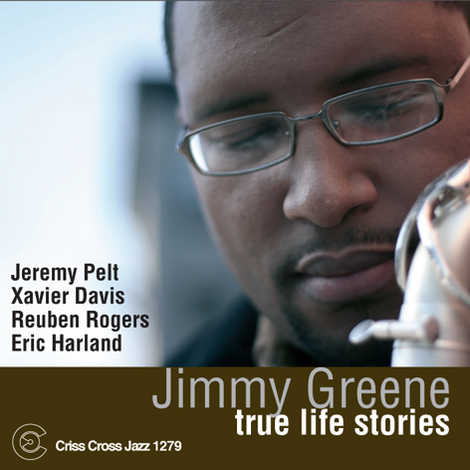
Review of True Life Stories
"Winning spins" from Hot House
August 2006
By: George Kanzler
Reviews of The Overcomer's Suite
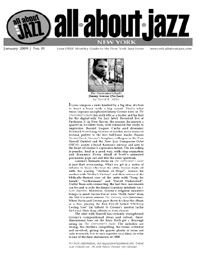
All About Jazz |
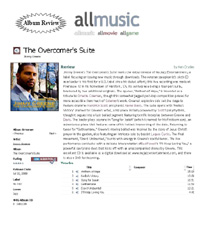
All Music |
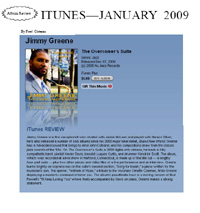
iTunes |
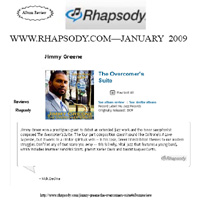
Rhapsody |

Review of True Life Stories
"Winning spins" from Hot House
August 2006
By: by George Kanzler
Herring and Greene showcase working bands that are quartets on their CDs, although both leaders also employ the same guest trumpeter, Jeremy Pelt, on some tracks. Herring's rhythm section is his "European band," the one he's worked with mostly on that continent, although the players aren't necessarily based there. It consists of Danny Grissett, piano; Essiet Essiet, bass, and Joris Dudli, drums. Greene's New York based rhythm section is Xavier Davis, piano; Reuben Rogers, bass, and Eric Harland, drums.
Ends and Means (High Note), remains true to alto saxophonist Herring's roots in hard bop and soul jazz, roots planted early when he was chosen by Nat Adderley to carry on the legacy of Julian "Cannonball" Adderley in Nat's tribute band to his late brother. The title track is firmly in that tradition, structured around a winning tension-release song form. Swiss-born, Vienna-based drummer Dudli contributes spunky, off-kilter funk rhythms to two of his originals, "Tom Tom," marked by a pronounced backbeat, and "Thoughts," with a slinky rhythm aided by unison piano and bass, and a tonally distinct combo of Harmon-muted trumpet and soprano sax (Herring's one outing on that instrument).
Grissett, whose piano solos consistently stand out, also contributes an asymmetrical arrangement of Irving Berlin's "The Song Is Ended" for the quintet, with suspended A sections and an Afro-Latin tinged bridge. A surprising standout track is a quartet version of the Beatles' "Norwegian Wood," done in the style of John Coltrane's "My Favorite Things," that surges along with stirring momentum and passionate solos from both the leader and Grissett.
If Herring's album is an affirmation of his roots, with some funky contemporary touches, Jimmy Greene's True Life Stories (Criss Cross), is a more searching, stylistically open album. Not only is tenor saxophonist Greene's repertory more varied - from pop standards to Thelonious Monk to religious music - but he employs a variety of configurations, from duo to quintet to two different quartets. There's a pliable, open quality to the rhythms too, largely a product of Harland's singular style, with its unusual, for these times, reliance on sticks on drum skins as much or more than on cymbals.
Greene has a wide command of tenor tone, and can keep it light and keening, as on his mid-tempo "Re-Affirmation," with the rhythm section; gritty and shouting on "Evidence/True Life Stories," a conflation of a Monk tune and his own melody done in a piano-less quartet; or warm and breathy on a romantic duo (with Davis) version of "My Ideal." He also has a clean, bright and tuneful soprano sax sound, displayed on both his own multi-tempo "Song for Isaiah" and the traditional hymn, "How Great Thou Art." His other foray into religious themes, the contemporary gospel number, "A Closer Walk," is given a Stevie Wonder twist made overt with Greene's "Isn't She Lovely" coda. And speaking of good pop songs, don't miss the closer, a lush, heart-beat tempo rendition of Harry Connick Jr.'s macho ballad "Take Advantage."
Trumpeter Pelt, a welcome presence on Herring's album, is even more essential in his three appearances with Greene, offering a meaty, contrasting solo to the soprano on "Isaiah" and interacting and soloing strikingly on the two pianoless quartet tracks, both definite album high water marks.
Jimmy Greene plays at Smoke on Aug. 18-19. Vincent Herring will be featured with the Cedar Walton group at Dizzy's Club Coca-Cola on Aug. 8-13 and 15-20.

Review of True Life Stories
All About Jazz
By: C. Andrew Hovan
Greene's writing is especially strong on True Life Stories; the melody on the opening "Re-Affirmation" is punctuated by shifting accents and hits. He negotiates the challenging structure with ease, then he quiets down for the start of his solo, building the tension while telling a story. His tone is consistent throughout the range of the horn, reaching for upper-register cries on occasion for textural variety. It's all there in the first eight minutes, setting the tone for the remainder of this wonderful set.
Trumpeter Jeremy Pelt steps up for "Song For Isaiah," which also finds Greene on soprano sax, an instrument that he plays with a great deal of fluency and creativity. Like his other compositions, this one also gains its charm through the use of a structure that breathes in a natural way both melodically and rhythmically, thus stepping away from the usual 32-bar head-with-solos format. Pianist Xavier Davis, bassist Reuben Rogers and drummer Eric Harland also help make these performances a success; they are especially sensitive to a less overt and more suggestive form of timekeeping.
Jimmy Greene truly comes into his own on True Life Stories, arguably his best effort yet as a leader. While his spiritual inspiration—as revealed in the liner notes and through the inclusion of the numbers "How Great Thou Art" and "A Closer Walk"—might have something to do with this recent growth spurt, his inherent musicality has held him in good steed previously, and now it looks like bigger and better things are on the way.
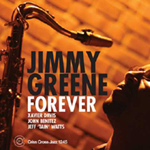
Review of Forever
JazzReview.com " Featured Artist: Jimmy Greene" - 2004
By: C. Andrew Hovan
Robust in tone and consistently strong across the full range of his instrument, Greene has full technical command of his horn. Just check out the opening dialogue with Watts on "In Many Tongues" and you'll hear the saxophonist going through the permutations with that ardent upper register 'cry' that helps form the emotional foundation. On Ellington's "Come Sunday" the familiar melody is almost undetectable as Greene strolls along accompanied simply by just bass and drums. His reworking of the pop tune "You Make Me Feel Brand New" is undeniably strong, with Watts providing a funk/bossa hybrid for the groove.
It's obvious throughout this varied set that Greene has unfettered communication with his cohorts. They seem to breath as one, but at the same time give things a loose feel that allows the soloist to take chances without fear of falling. This is one of the strongest saxophone quartet records of the year and I wouldn't be surprised to find it turn up on more than a few year-end top ten lists.

Review of Forever
Jazztimes "Saxophonics" - December 2004
By: David Franklin

Review of Forever
All About Jazz - August 2005
By: Javier AQ Ortiz
Perhaps the most obvious and reachable example would be the opener. Written in 1913 by George Bernard, "The Old Rugged Cross" develops into a contemporary straightahead proposition featuring tight harmonic, rhythmic, and melodic group interactions whose freedoms and variations can be described as "change'n the pocket." Therein the listener immediately meets head on with solos from Greene on tenor sax, Xavier Davis on piano, and Jeff "Tain" Watts on drums. Although bassist John Benitez's turn in the spotlight would have to wait until the cool-headed stroll of Duke Ellington's "Come Sunday" and the contagious swing of "Power," one is immediately impressed by this quartet's muscle, flair, and sensibility.
Greene's facility with his instruments, both obvious and remarkable, is also a celebratory event. One can talk about the tenor sax glossolalia-like head exchange with Watts on "In Many Tongues"; the eminently sensitive, loving, and engaging anthemic soprano meditations of "He is Lord"; the title cut, featuring pianistic wonderment from Davis; the mid- to low-toned tonguing of "You Make Me Feel Brand New," as well as its higher reaches; or the classical tone and attack of "Power."
Further celebration stems from Greene's writing, overall musical concept, and leadership. He assails accessibility, rhythm, and melody with unfathomable harmonic strength, of which "NMG" is quite an instance. Unafraid of the musical prowess of their companions, these musicians cull their respective individuality within statements that dare the power of superbly supported melody.
 Review of Forever
Review of Forever
4 stars ****
Jazzwise Magazine (UK) May 2004
By: Tony Hall
A Jackie McLean pupil, who is highly praised by his teacher, but whose style is totally different, Greene first caught our attention as a sideman on a not particularly brilliant Horace Silver record. His first date as a leader was on Criss Cross in 1997, then BMG signed him. Their album, Brand New World was excellent, but they abruptly dumped him! Now he's back with Gerry Teekens (for whom he'd recorded some great sets with Ralph Peterson's Quintet, now sadly disbanded) and Forever is a fine album. The mood throughout is serene and spiritual, even at uptempos, and there is quite remarkable cohesion between Greene and his outstanding rhythm section. [Xavier] Davis (a colleaugue in Tom Harrell's Quintet and a founder member of The New Jazz Composers Octet) is, like Greene, an exceptionally sensitive soloist, who uses space so effectively, while [John] Benitez on bass in solo or section is a revelation. As for Tain, he plays with unusual restraint, but still keeps the pot boiling at all tempos. 'Power," in particular, is a real burner.
Greene is without doubt one of the most striking young tenors of recent years and some of his best work here is on a piano-less version of Ellington's 'Come Sunday.' The leader contributes five originals ('Forever' is a moving soprano feature) and there's a version of Thom Bell's 'You Make Me Feel Brand New' which really starts to take off halfway through Davis' soulful piano solo. A peaceful, but powerful, record and thoroughly enjoyable.
Review of Forever
allmusicguide.com
By: Al Campbell
Forever marks the second release on the Criss Cross label by tenor saxophonist Jimmy Greene. These eight tracks embrace both traditional and fresh arrangements guided by a spiritual nature. The interpretations of "Old Rugged Cross" and Duke Ellington's "Come Sunday" are compelling, as is "You Make Me Feel Brand New," originally recorded by the Stylistics and not necessarily thought of as a spiritual, but in this context the song fits perfectly. Of the five Greene originals, "In Many Tongues" and "Power" are standouts given the overtly celebratory concept and execution backed by a powerful rhythm section of Xavier Davis on piano,John Ben'tez on bass, and Jeff "Tain" Watts on drums,Greene and his cohorts' reverence is obvious but thankfully not overbearing; they never forget that this is a jazz date and supposed to swing.
Review of TomHarrell Live at the Village Vanguard (RCA Bluebird)
JazzTimes Magazine
July/August 2002
By: Doug Ramsey
"Greene is increasingly impressive in his construction of melodic lines that have the intimate quality of good speech..."
--Tom Harrell
"Jimmy is phenomenal. He has a really creative imagination and beautiful feeling. His tone is big and warm and beautiful. It's a pleasure working with him."
--The New Yorker, September 1, 2003
"Greene, a no - nonsense neo - bop tenor saxophonist whose conviction helps him stand out in the crowd"
--Ben Ratliff, The New York Times, August 29, 2003
"Mr. Greene is a strong young tenor saxophonist... he'll have a lot to offer in the long run."
--Jim Macnie, The Village Voice (NYC), August 29, 2003
"Jimmy Greene . . . . the tenor player is good for a couple of body chills every time you see him. He's got a big barrelhouse sound, and a way of negotiating changes that makes academic moves seem natural."
--Gary Giddins, The Village Voice (NYC), May 30, 2003
"[Jimmy Greene is] a talented saxophonist who has been a member of Tom Harrell's band for several years . . . . he has a big tone and lithe style, and is one of those players who came along in the '90's who constantly seems on the verge of a breakthrough."
--Britt Robson, City Pages Minneapolis,MN, May 14, 2002
Review of Tom Harrell Quintet at Dakota's in St. Paul, MN
"The highlight of the set came right away, on "Daybreak," rendered with breakneck speed and robust tonality. Tenor saxophonist Jimmy Greene, like Harrell a Horace Silver alumnus, kicked off the solos in torrid fashion, melding a fat sound with phrases that were by turns darting, angular and serpentine, a bravura style reminiscent of Dexter Gordon."
--Don Heckman, Los Angeles Times, June 21, 2002
Review of the Tom Harrell Quintet at the Jazz Bakery, Los Angeles, CA
". . .Greene's big, brash saxophone sound provided the perfect extroverted counter for Harrell's inner searching."
--John Nemo, St. Paul (MN) Pioneer Press, May 14, 2002
Review of Tom Harrell Quintet At Dakota's in St. Paul, MN
"Then there's Jimmy Greene on sax, taking his spiraling solos when called on, then matching [Tom] Harrell note-for-note when asked to help supply the melodies."
--Jack Massarik, Evening Standard, London, England, March 2002
Review of Ralph Peterson Quintet At Ronnie Scott's in London
"Jimmy Greene, a towering young tenorist of abundant talent, keeps his head down and weathers the storm in neo-Coltrane style..."
--George Kanzler, Newark Star-Ledger, April 14, 2001
Review of "Miles Again" tribute to Miles Davis by the Carnegie Hall Jazz Band, John Harms Center for the Arts, Englewood, NJ
"Saxophonists Greene and [Vincent] Herring found solo stances within the mood of the pieces, referencing but hardly aping the original solos of John Coltrane and Julian "Cannonball" Adderley. Greene was especially graceful..."
--Bob Blumenthal Boston Globe March 24, 2000
Review of the Kenny Barron Quintet at the Regattabar, Cambridge, MA
"Greene in contrast wove discrete, agitated phrases into a statement of surprising continuity, relying heavily on John Coltrane's late-quartet vocabulary and the inspiration to be drawn from the rhythm section's turbulent commentary. . . . Greene sliced against their ominous groove, tearing off anguished harmonics at one point."
--Willard Jenkins, JazzTimes Magazine, March 2000
Review of Brand New World
"Now comes Brand New World, Jimmy Greene's fresh entr'e on the RCA Victor label. Sparkling in its promise, subtle in its gifts, Brand New World delivers a tasty platter.."
--Cliff Bellamy, Durham (NC) Herald Sun, January 14, 2000
Review of Brand New World
"[Greene's] solo on "Mr. McLean" is a work of fire and passion, but at other times, such as on the ballad "Never Let Me Go," Greene can "sing" with great expression and lyricism."
